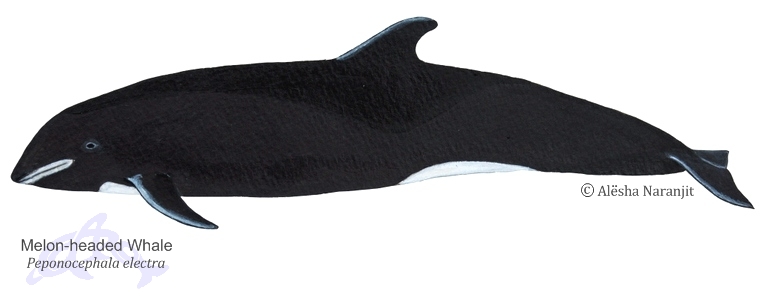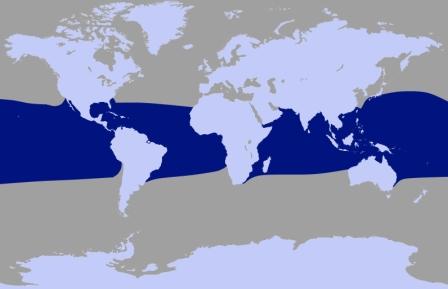Peponocephala electra

Classification Other Names: Little Killer Whale, Many-toothed Blackfish, Electra Dolphin, Suborder: Odontoceti Family: Delphinidae | Description These animals are usually very social among themselves but are shy of boats and seldom bow-ride. They can be fairly surface active when undisturbed and often associate with fraser's, rough-toothed, spinner, spotted and bottlenose dolphins.
|
Melon-headed Whale Ecology Range: Tropical and subtropical waters between 40ºN - 35ºS. There have been records of strandings at higher latitude associated with incursions of warm water but these are thought to be unusual. Usual Habitat: Often found in offshore waters but can be found in deep, near-shore waters. Usual group size: 100 - 500 individuals (exceptionally 1000-2000) Main Diet: fish, squip and occasionally crustaceans Local population: Unknown | Global range of the Melon-headed Whale  Dark blue area indicate where Melon-headed Whales are likely to be found |
Protection and Conservation Status
IUCN Conservation Status: Melon-headed Whales are listed as "Least Concern" on the IUCN red list. SPAW Protocol: Melon-headed Whales are cetaceans, which are listed under Annex II of the SPAW protocol. As such they require total protection under article 11 of this protocol which prohibits the "taking, possession, killing and commercial trade of the species, their parts or products". The SPAW protocol was created to help with the implementation and promotion of the Ramsar Convention and the Convention on Biological Diversity. The Annexes of the SPAW protocol can be found here. Local Laws: Cetaceans are protected under the Conservation of Wildlife Act of Trinidad and Tobago which offers protection to all species not listed under the second or third schedules of this act. |
This is currently being researched and written. It will appear here shortly.
References
The above information was obtained from the following sources:
- A Princeton Field Guide: Whales Dolphins and Other Marine Mammals of the World by Hadoram Shirihai and Brett Jarrett (2006)
- Smithsonian Handbooks: Whales Dolphins and Porpoises by Mark Carwardine and illustrated by Martin Camm (2002)
- The Whale and Dolphin Conservation Society's Species Guide at http://www2.wdcs.org/species/index.php
- The IUCN Redlist at http://www.iucnredlist.org
- The SPAW protocol Annexes with links available at http://www.car-spaw-rac.org/?Annexes-of-the-SPAW-Protocol,83
Acknowledgements
We would like to thank the following people for the use of the art work and photographs:
- Alësha Naranjit (Illustration of Melon-headed Whale)